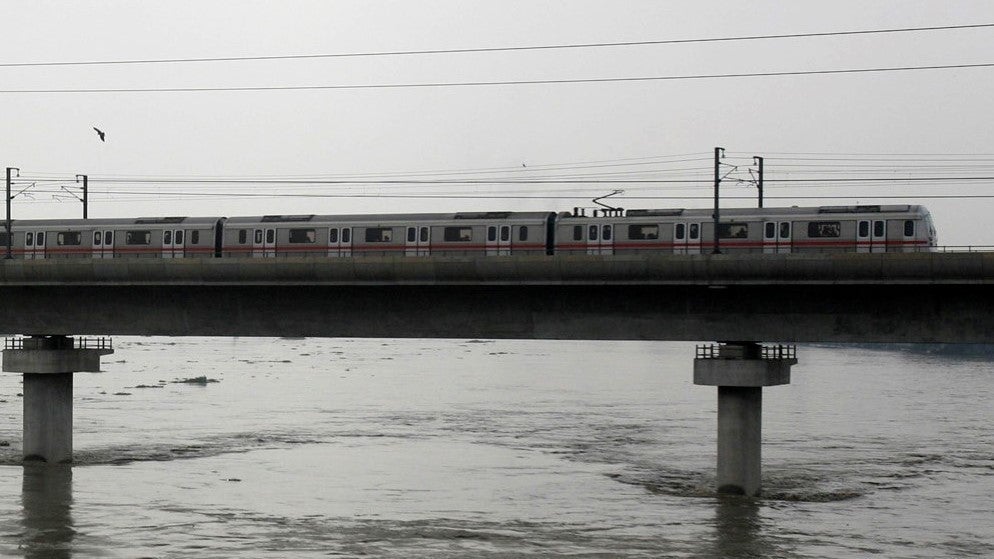As India readies an underwater line, here’s a look at its various metro networks
Thirty-five years after Kolkata, capital of the eastern Indian state of West Bengal, got the country’s first metro service in 1984, it is readying for another milestone: India’s first underwater metro.


Thirty-five years after Kolkata, capital of the eastern Indian state of West Bengal, got the country’s first metro service in 1984, it is readying for another milestone: India’s first underwater metro.
The service is expected to commence next month and will run underneath Kolkata’s Hooghly river, Indian railway minister Piyush Goyal announced on Twitter on Aug. 8.
Sharing a video of the upcoming underwater train, the minister called the project an example of “excellent engineering.”
The underwater train will cover 16.6 km on the city’s East-West Metro project. The route includes 10.6 km of tunnels 520 metres long and about 30 metres deep. Travellers between Howrah and Mahakaran stations in Kolkata will be under the river for only about a minute as the metro train will run through the tunnel at a speed of 80 km per hour.
Tracking metro network
Over the years, India has gone big on its metro network in a bid to decongest crowded city roads and reduce pollution. The country now has 13 such rapid transit systems, covering 638.91 km with over 450 stations in key Indian cities such as Delhi, Mumbai, Hyderabad, and Chennai, among others.
Several others, like Agra and Pune, too, are building their own networks. Here’s a look at few of the existing metro networks:
Delhi Metro: The Delhi Metro Rail Corporation (DMRC) is credited with building and operating the country’s largest network of rapid transit (373 kms with 271 stations). DMRC opened its first corridor between Shahdara and Tis Hazari on Dec. 25, 2002.
Delhi Metro connects the capital with neighbouring cities such as Gurgaon, Faridabad, and Bahadurgarh in Haryana, and Noida and Ghaziabad in Uttar Pradesh. Operating 300 train sets of four, six, and eight coaches, it ferries an average of 4.7 million passengers daily.
DMRC has been certified by the UN as the world’s first such service to get carbon credits for reducing emissions.
Gurugram Metro: The Delhi Metro extends into Gurugram, the satellite town of neighbouring state Haryana. The Haryana government plans to extend metro connectivity further into the state. Gurugram also boasts of an elevated 12 km rapid metro connecting IT hubs within the city.
Mumbai Metro: Service began in India’s financial capital in June 2014, with an 11.4 km corridor connecting Versova, Andheri, and Ghatkopar. This was India’s first metro railway project implemented using the public-private partnership model by a consortium headed by Reliance Infra.
By 2022, Mumbai Metro plans to have a network of 200 km. The Mumbai Metropolitan Region Development Authority is working on four metro corridors. Once these are operational, Mumbai Metro is expected to ferry 9 million passengers daily.
Hyderabad Metro: Launched in November 2017 between Miyapur and Nagole, the first phase of the project covered 30 km. As of June 2019, Hyderabad Metro’s phase I operates a stretch of 56.5 km and 48 stations, out of the planned 71.16 km and 64 stations.
The company is struggling with low ridership due to high ticket prices and poor last-mile connectivity. Metro fares in the city are higher compared to the suburban train system that operates there.
The metro was expected to carry about 1.7 million passengers per day by 2017 and 2.2 million by 2024. As of April this year, it carried only 0.255 million passengers on average.
Bengaluru Metro: Christened Namma Metro, this network in India’s premier IT hub has the fourth-longest network in the country after Delhi, Hyderabad, and Chennai. It was launched in October 2011 and now covers 42 km, with an average daily ridership of 0.4 million passengers.
By 2024, the network is likely to expand to 170 km.
Kochi Metro: This service in the southern state of Kerala was launched in 2017. The 13 km stretch covering 11 stations was touted to be the longest first phase of a metro made operational in one go.
It has been built by DMRC and supervised by E Sreedharan, popularly known as India’s metro man for leading and launching metro in Delhi.
Kochi Metro was the first in the country to use communication-based train control technology to maximise frequencies and minimise errors. It also took the lead in employing transgender people at stations.
Lucknow Metro: Service began in 2017, covering a distance of 22.878 km with 21 stations. Lucknow Metro has an average ridership of 60,000 passengers a day over 331 trips.
Jaipur Metro: The capital city of the western state of Rajasthan got its own metro in June 2015. It’s the first metro in the country to run on a double-storey elevated road and metro track. Completed in a record time of four-and-a-half-years, the Jaipur Metro is touted to be one of the fastest metros to be built in the country.
Nagpur Metro: Metro services in Nagpur began in March this year. The city has a network of 13.5 km. The work is on to extend the network’s total length to 38 km. About 65% of the electricity used by Nagpur Metro will come from solar energy, making it the country’s greenest metro.
Correction: An earlier version of this story said that Lucknow Metro has an average ridership of 60 million passengers each day. It has an average of 60,000 passengers each day.